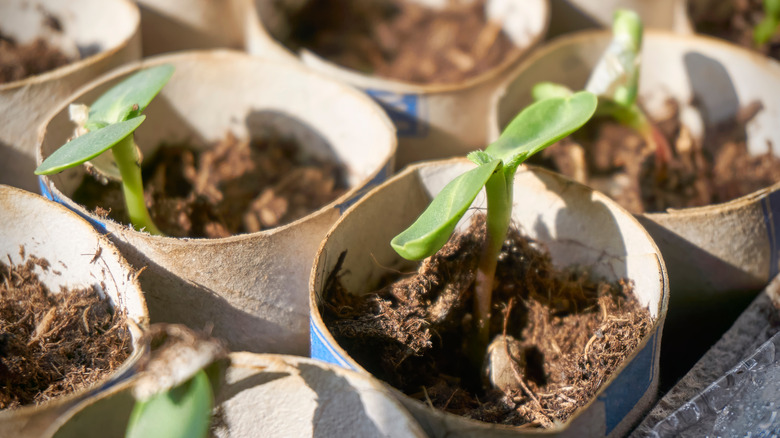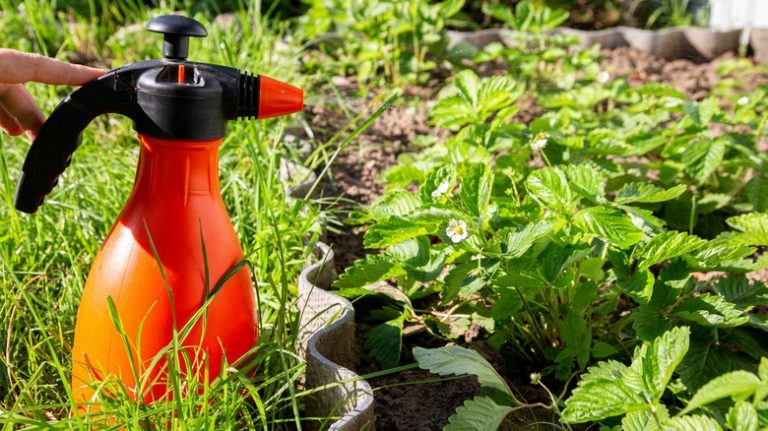With the ever-growing cloud of climate change looming overhead, reducing waste and repurposing everyday items has never been more important. One way to support the environment is to find new ways to use toilet paper. Since toilet paper is biodegradable, it works well in a garden setting. Not only does it break down easily, but it also dissolves quickly when wet. The important thing to remember when recycling toilet paper in soil and around plants is to only use brands that are free from bleach, dye, and chemical additives.
There are a host of creative ways to use this essential bathroom product in the home garden. From growing herbs to fixing bald patches in the yard to protecting plants from cutworms, you’ll find toilet paper quickly climbing to the top of your supply list. You’ll also discover that these repurposing hacks save you money and make garden tasks much more manageable.
To clearly mark seeds
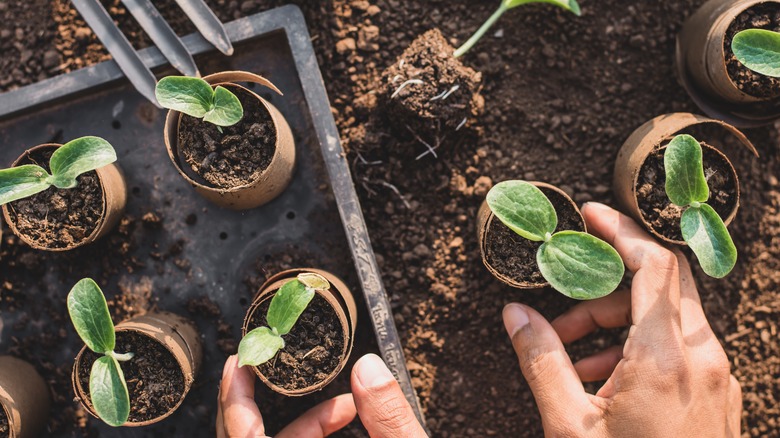
When you plant seeds in a garden, you’ll need a way to quickly distinguish seed growth from weed growth. This is where old toilet paper rolls come in handy as circular barriers. Since the seeds grow inside the center of each toilet paper roll, any sprouts outside the rolls are easily verified as weeds. Remove the weeds as soon as you spot them to prevent them from diverting nutrients from your seedlings, which need plenty of nutrition to grow healthy and strong.
To create your seed markers, cut each toilet paper tube in half. The tubes only need to be about 2 inches long, and most toilet paper rolls measure 4 inches. As you plant each seed in the garden soil, slide a tube over it so that the seed rests in the center of the circle. You want to press the tube in deep enough so that it stays put, yet still leave some of it sticking up above the soil for easy identification. Keep an eye on the garden and pull any sprouts you see growing outside the toilet paper markers.
To help herbs grow in a kitchen garden
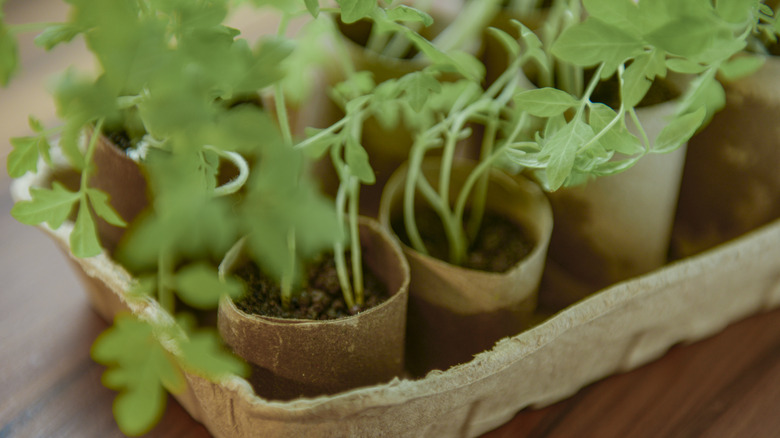
Herbs can be grown in a garden kitchen, which is helpful for those in cities with minimal outdoor space. Since toilet paper rolls measure approximately 4 inches in length, they can be used as a sort of flowerpot for growing herbs with short roots, such as chives, basil, and mint. For herbs with longer roots, like parsley, oregano, and thyme, simply switch to a paper towel roll instead.
Choose a window that faces either south or west to set up your herb garden. If this isn’t possible, you can use a set of grow lights as a replacement for natural sunlight. Find a plastic container with drainage holes to hold your toilet paper roll pots. Place the rolls side by side and begin filling them with a well-draining potting mix. Plant one seed in each pot and then water until the soil is moist, but not soggy. Continue following the recommended care requirements for the specific herb you’re growing, which you should find on the back of your seed packet.
As part of a compost pile
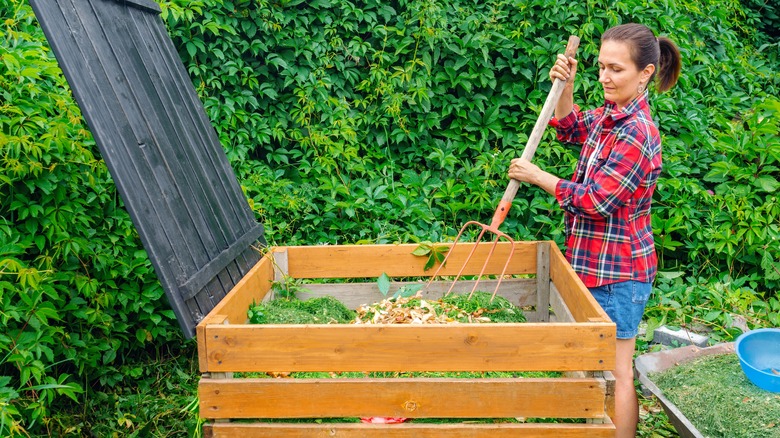
nieriss/Shutterstock
In order for compost piles to provide your garden with extra nutrients, they need to contain both “browns” and “greens.” The “browns” add carbon, while the “greens” provide nitrogen. Since toilet paper rolls are constructed from cardboard, they can be used in the bins as part of the required “browns.” Just make sure to break the rolls up before you make your compost pile, as whole tubes will take too long to decompose.
Grab a pair of scissors and cut your toilet paper rolls up into small strips. Toss them on the bottom of your compost pile along with other shredded “browns,” such as newspaper sheets, napkins, paper plates, and pizza boxes. Build the pile to a height of 4 to 5 inches. Next, add a 2- to 3-inch layer of “greens” like grass clippings, eggshells, vegetable scraps, and chicken manure. Repeat these layers until your pile is approximately 4 to 5 feet tall and at least 3 feet wide. Water the pile at least once per week and aerate it every 3 to 4 days (every 2 to 3 weeks for longer decomposition) by tossing the ingredients with a shovel or pitchfork. Once the compost pile begins to have an earthy scent, you can begin using it to amend the soil in your garden.
To make your own seed tape
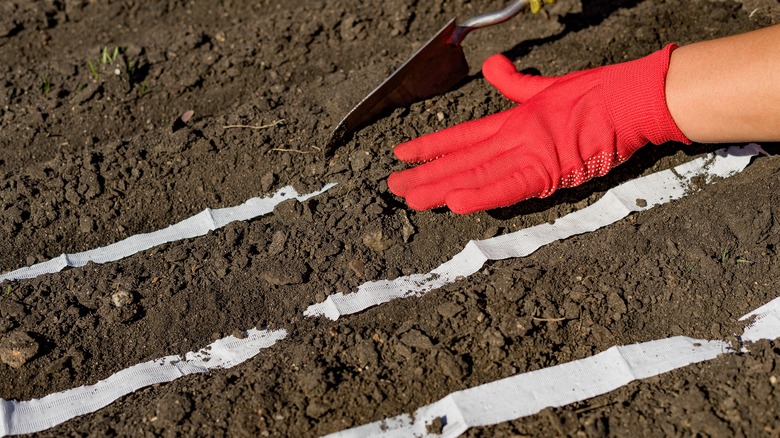
UncleFedor/Shutterstock
Seed tape can be planted directly in the soil and is used to help properly space small- and medium-sized seeds. It can also save you money by eliminating overcrowding and reducing seed waste. While you can purchase seed tape at any garden center, it’s extremely easy to make yourself at home using toilet paper and a glue made of flour and water.
Roll the toilet paper out to match the length of the row in your garden. Check your seed packet to determine the recommended amount of space between seeds. For example, it’s best to space spinach seeds 3 inches apart, while cucumbers need a full 12 inches between seeds. Create a homemade glue by mixing 2 tablespoons of flour with 1 tablespoon of water. Set a drop of the glue on the toilet paper where you plan to lay each seed and add them over each spot. Add a layer of toilet paper on top of the seeds, wait for the homemade glue to dry, and then plant the seed tape.
To create a bird feeder
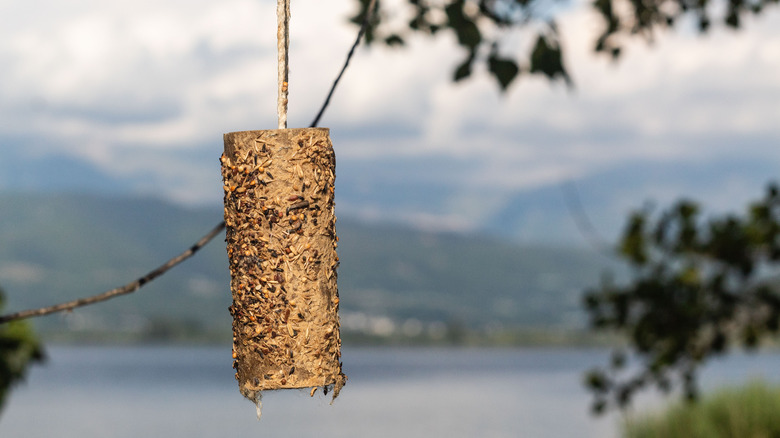
Adam Kipris/Shutterstock
If you’re looking to attract birds to your yard, consider crafting a bird feeder using an old toilet paper roll. This is an excellent project for kids and adults alike. Before you begin, you may want to purchase a field guide to identify all of the lovely, feathered creatures that come to feast on your feeder.
Punch a hole near the top of the toilet paper roll and thread a piece of twine through it. Create a loop (large enough to fit around a tree branch) and tie a knot at the end to secure it. Next, coat the entire outside of the toilet paper roll with peanut butter. Peanut butter is sticky enough to hold bird seed in place and also safe for birds to eat. Pour birdseed on a plate and then rotate the toilet paper roll over the seeds until all of its sides are coated equally. Hang the roll from a branch and wait for the birds to arrive.
Note: PennState Extension recommends replacing peanut butter with a cooking fat like shortening if anyone in your home has a peanut allergy.
As a mulch
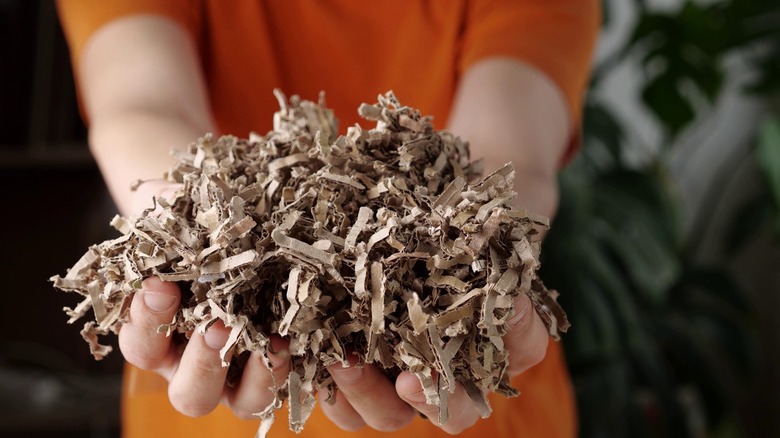
Fevziie/Shutterstock
Mulch is essential for gardens, as it not only helps retain moisture but also insulates plant roots. Additionally, mulch does an excellent job of suppressing weeds, which compete for the nutrients your plants need to thrive. Many items can be used to create mulch, so you can make your own at home and save a few bucks. One such method uses old cardboard toilet paper rolls.
Before you place the cardboard rolls in the garden, cut them up into small pieces. If you find yourself a bit short, add other shredded cardboard to your mulch pile, like paper towel rolls and packing boxes. Once spring has arrived and your plants have begun to grow, apply the homemade mulch. It’s best to surround each plant — but avoid placing the mulch directly against the plant’s stem.
To grow oyster mushrooms
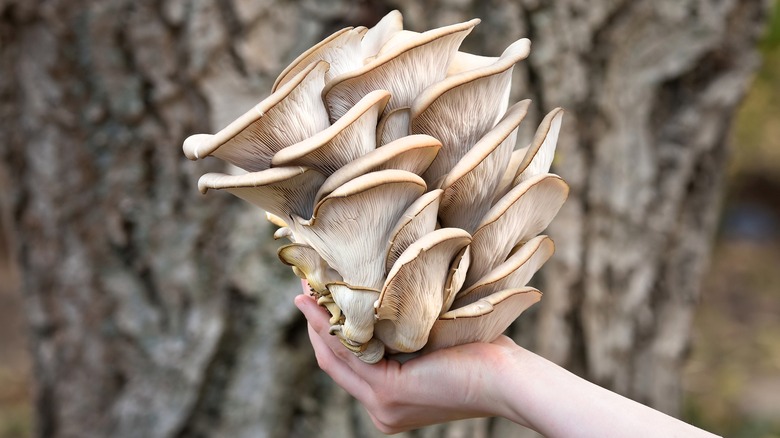
Coryn/Shutterstock
Oyster mushrooms (Pleurotus ostreatus) don’t have a strong flavor, so they can be added to a wide variety of dishes. They offer a host of important health benefits, including providing your body with niacin, vitamin B5, and potassium. They are also an excellent source of antioxidants. If you enjoy cooking with mushrooms, oyster mushrooms are one of the easier species to grow at home. In fact, you can grow them right inside a roll of toilet paper.
Place a full roll of toilet paper in a bowl of water until the moisture has penetrated every layer. Remove the roll and set your mushroom spawn in the center. Slide the toilet paper roll inside a 1-gallon zipper bag and place it in a room that remains at 60 to 80 degrees Fahrenheit. You’ll also need to make sure the roll is exposed to light, whether sunlight from a nearby window or an artificial grow light. Mist the toilet paper roll twice per day using a spray bottle and watch for growth. Once the caps are a little over an inch, you can remove them and use them in your favorite dishes.
To germinate seeds
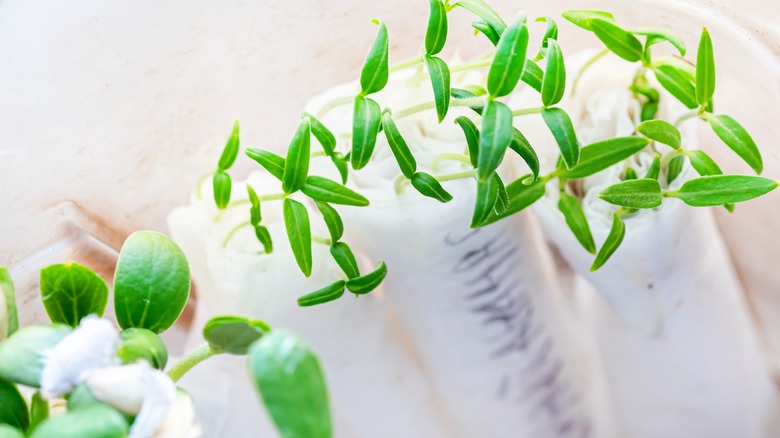
Lipatova Maryna/Shutterstock
Another genius way to use toilet paper in the garden is to help germinate seeds. By germinating the seeds before planting you’ll not only speed up the growth process but also be able to identify any problems that arise and take immediate action to ensure successful plant growth. When germinating the seeds of edible plants using toilet paper, it’s important that you only opt for brands that are free of bleach and other chemicals. Additionally, you’ll want to avoid using paper towels — some gardeners find that the sprouts are harder to remove from these products.
Cover the bottom of a plastic container with sheets of toilet paper and then use a spray bottle to moisten them. Set the seeds on the toilet paper with the shoots facing downward, being sure to space them as instructed on the seed packet. Place a lid over the container and label it if working with more than one seed variety. Set the container in a location that remains above 65 degrees Fahrenheit and keep the toilet paper moist by spritzing it with water as needed. Once the seeds have germinated, you can plant them in the ground.
To trap slugs
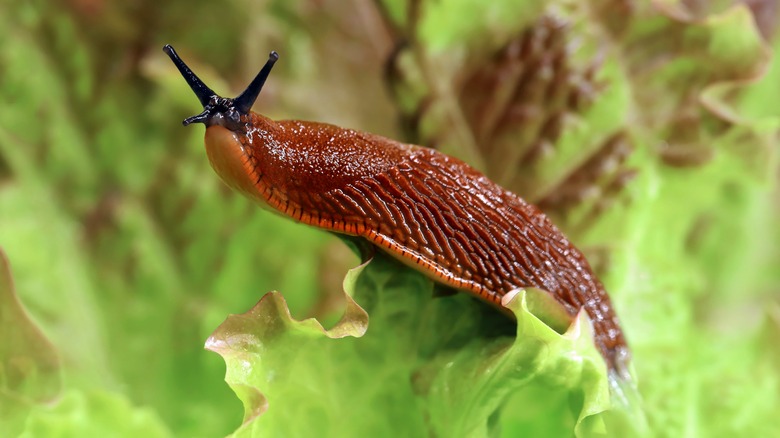
MakroBetz/Shutterstock
Slugs are known to damage a number of plants in the home garden, as they enjoy dining on leaves and other plant parts. If you notice any slime trails near the injuries, it’s a safe bet to assume you’re dealing with a slug infestation. The quicker you take action, the better. In addition to altering your garden to be less attractive to slugs, you’ll want to trap and remove the pests to eliminate them from your space. You can do this using a few old toilet paper rolls.
Since slugs tend to hide in the early morning hours, you can trap them by giving them a place to take cover. Spray a few toilet paper rolls with water until they’re moist, as slugs prefer a moist environment. Set the rolls on the ground near the plants that have shown signs of slug damage and wait until morning to check the traps. If you successfully catch any slugs, put on a pair of gloves, pick them up, and drown them in a container of salty or soapy water. When the slugs are dead, toss them back into your garden.
To clean plant leaves
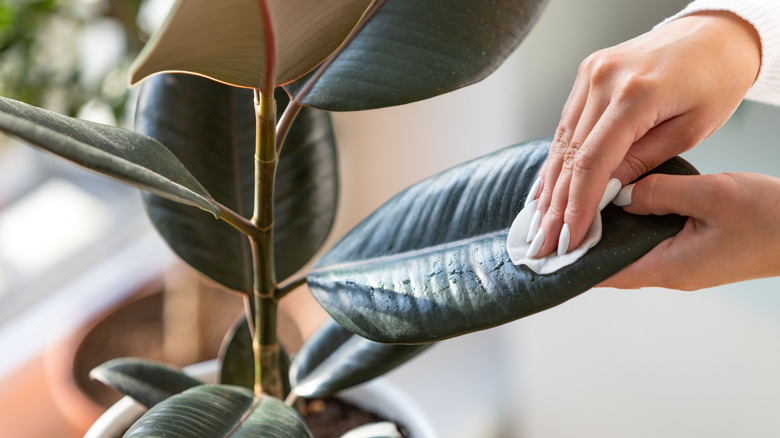
DimaBerlin/Shutterstock
Adding a few houseplants to your living space is a great way to purify the air inside your home. According to a 1989 study conducted by NASA, certain houseplants — like Gerber daisies, peace lilies, and potted mums — were able to remove chemicals from the air. Keeping the leaves of those plants clean and free of dust is a great way to ensure they remain healthy. One way to accomplish this is by gently wiping down the leaves with toilet paper.
While you can simply take the toilet paper and begin wiping the plant, there are also natural leaf cleaner sprays on the market that provide a more thorough clean. In the event that you spot tiny insects like aphids or mealybugs on the underside of your plant’s leaves, add a few drops of neem oil to the toilet paper before you wipe. Neem oil is a natural insecticide that eliminates pests without harming the plants.
To fix bald patches in the yard
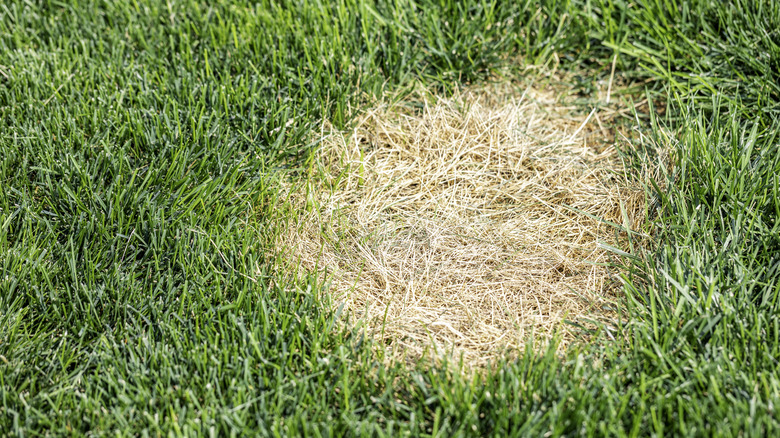
Garrett Aitken/Getty Images
Bald patches in a lawn are unsightly and typically indicate a problem. The patches may be the result of a chemical burn, grub infestation, or dehydration. After you’ve identified the issue and made the necessary corrections, you can begin growing new grass seed within the bald patches to restore the lawn to its original beauty. One way to do this is to create a seed paste using toilet paper and grass seed.
Start by shredding a roll of toilet paper into tiny pieces in a large bowl. Add water a little bit at a time until you have the consistency of a thick paste. Toss in some grass seeds and mix them with the water thoroughly. You can do this with your hands. Now, spread the toilet paper paste evenly across the bald patches in your yard. The mixture is heavy enough to keep the seeds in place yet biodegradable, so you won’t have to worry about removing it later on.
To protect plants from cutworms
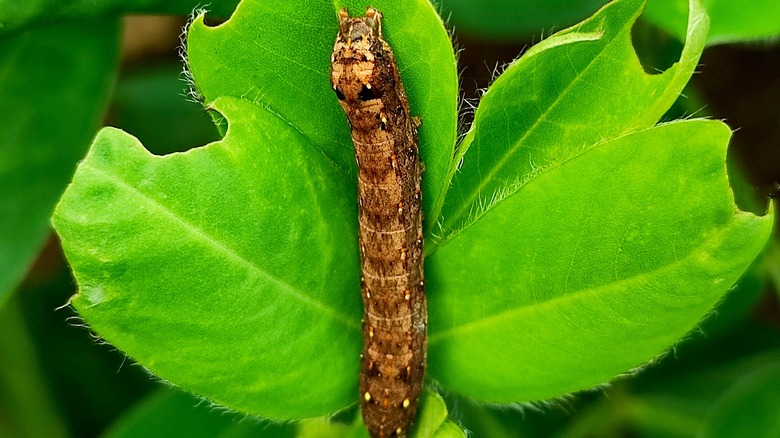
Willybald/Shutterstock
One of the most damaging plant pests is the cutworm. These plump caterpillars chew right through the stems of your newly planted vegetables, shrubs, and vines. Since they do most of their feasting at night, you may not spot them before you come across the destruction they’ve caused. While you can remove cutworms by hand, it’s a good idea to protect plants from the caterpillars so that you never have to deal with them in the first place.
One affordable way to protect plants from cutworms is to create a collar from toilet paper rolls to place around the plants. Cut the toilet paper rolls down the center and wrap them around the plants’ stems. Now, press the rolls halfway down into the soil. Toilet paper rolls typically measure 4 inches, so you’ll have 2 inches of protection below the soil’s surface and 2 inches of protection above.
To neatly store your garden twine
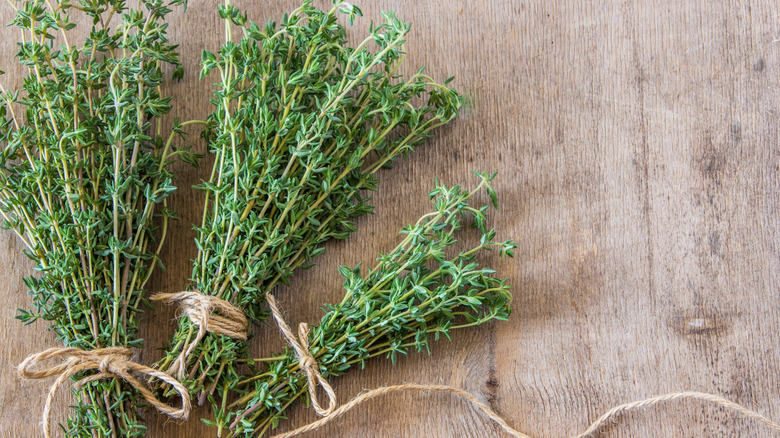
Artamonova Alla/Shutterstock
Garden twine has a host of uses in and around your plot of land. It can provide support for plants that need to be staked and can be used to hang fresh herbs up to dry. You can also use twine to create boundaries for different plants within the garden. The problem comes when you end up with extra twine after you’ve completed your projects. If you don’t properly store it, it will end up getting tangled into a bunch of knots. This is where rolls of toilet paper come in handy.
Garden twine can be wrapped around toilet paper rolls and stored for use later on. Cut a small slit in the top of the toilet paper roll and press the tip of one end of garden twine into the opening. Begin wrapping the twine around the toilet paper roll, working your way from the top to the bottom. Create a second slit in the bottom of the tube and press the tip of the other end of the garden twine into it. If you have a large amount of twine left over, use a paper towel roll instead.
To create a fairy house for your child’s garden
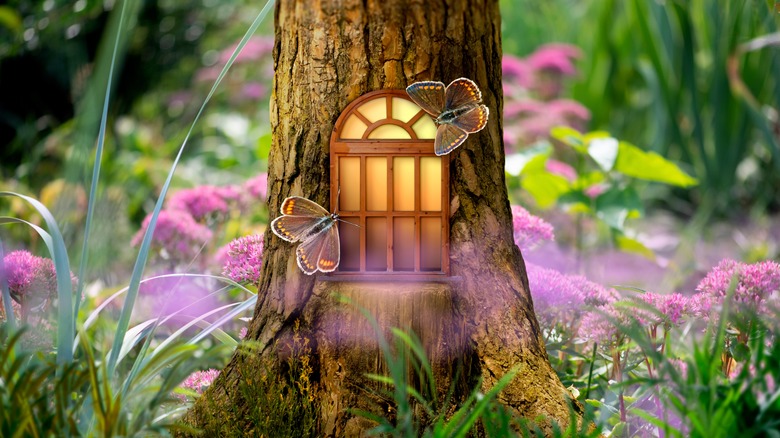
Julia Ardaran/Shutterstock
Helping your children create a fairy garden is an excellent way to introduce them to plants, soil fertilization, and landscape design. Of course, the garden will also foster imaginative play while giving the kids some much-needed fresh air. When organizing the fairy garden, encourage them to get creative and construct their own fairy houses out of toilet paper rolls.
Cut a U-shaped door out of the bottom of a toilet paper roll and then paint the roll your desired color. Create a cone shape from a piece of paper and glue moss over it to form a roof for your house. Flip the cone upside down and glue it to the top of the toilet paper roll. Set the house in your fairy garden and place a battery-operated tea light inside to produce a beautiful glow. Add any final touches, such as surrounding the base with acorns or arranging pebbles to form a walkway that leads to the house’s front door.

